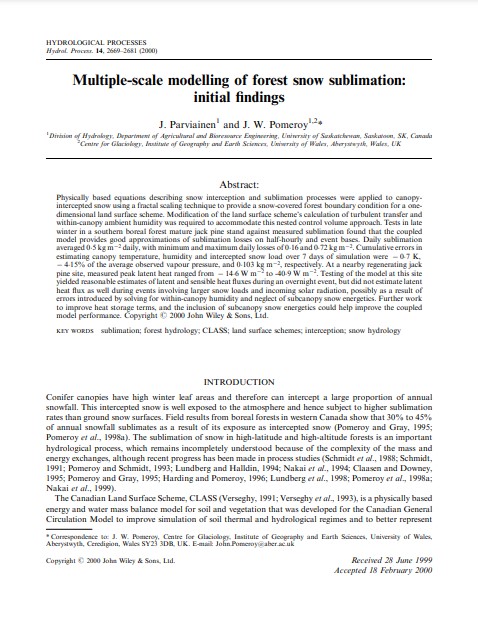Multiple-scale modelling of forest snow sublimation: Initial findings
Bosque Modelo:
Prince Albert
Temática:
Desarrollo humano
Tipo de documento:
Artículo científico
Resumen
Physically based equations describing snow interception and sublimation processes were applied to canopy-intercepted snow using a fractal scaling technique to provide a snow-covered forest boundary condition for a one-dimensional land surface scheme. Modification of the land surface scheme's calculation of turbulent transfer and within-canopy ambient humidity were required to accommodate this nested control volume approach. Tests in late winter in a southern boreal forest mature jack pine stand against measured sublimation found that the coupled model provides good approximations of sublimation losses on half-hourly and event bases. Daily sublimation averaged 0·5 kg m−2 daily, with minimum and maximum daily losses of 0·16 and 0·72 kg m−2. Cumulative errors in estimating canopy temperature, humidity and intercepted snow load over 7 days of simulation were −0·7 K, −4·15% of the average observed vapour pressure, and 0·103 kg m−2, respectively. At a nearby regenerating jack pine site, measured peak latent heat ranged from −14·6 W m−2 to -40·9 W m−2. Testing of the model at this site yielded reasonable estimates of latent and sensible heat fluxes during an overnight event, but did not estimate latent heat flux as well during events involving larger snow loads and incoming solar radiation, possibly as a result of errors introduced by solving for within-canopy humidity and neglect of subcanopy snow energetics. Further work to improve heat storage terms, and the inclusion of subcanopy snow energetics could help improve the coupled model performance. Copyright © 2000 John Wiley & Sons, Ltd.
Información Bibliográfica
Autor:
Parviainen, J and JW Pomeroy.
Revista:
Hydrological Processes
Año:
2000
N°:
-
País :
Canadá
Páginas:
2669 - 2681
Volumen:
14
Idioma:
Ingles
Palabras claves
sublimation; forest hydrology; CLASS; land surface schemes; interception; snow hydrology





